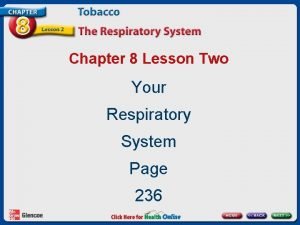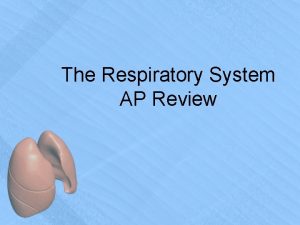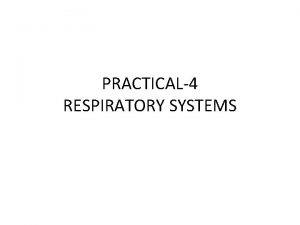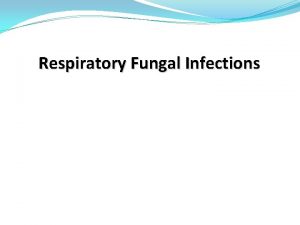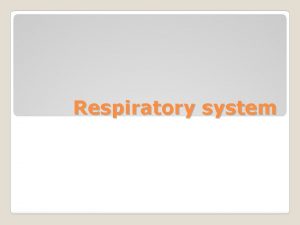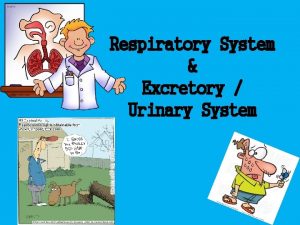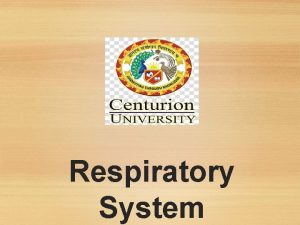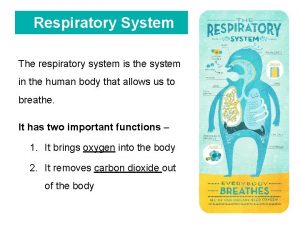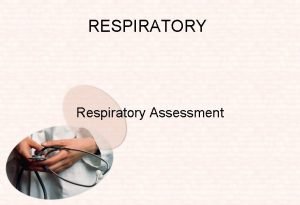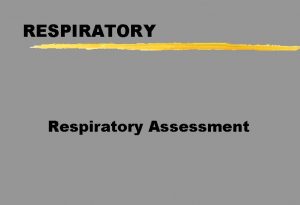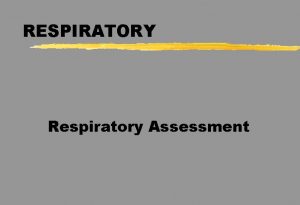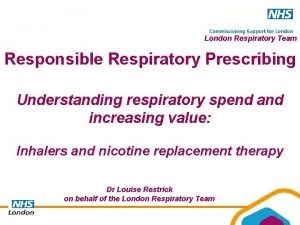What is the respiratory system Your respiratory system
































- Slides: 32

What is the respiratory system? Your respiratory system is made up of the organs in your body that help you to breathe. Remember, that Respiration = Breathing. The goal of breathing is to deliver oxygen to the body and to take away carbon dioxide

Parts of the respiratory system

lung trachea bronchi diaphragm


Lungs • The lungs are the main organs of the respiratory system. In the lungs oxygen is taken into the body and carbon dioxide is breathed out. The red blood cells are responsible for picking up the oxygen in the lungs and carrying the oxygen to all the body cells that need it. The red blood cells drop off the oxygen to the body cells, then pick up the carbon dioxide which is a waste gas product produced by our cells. The red blood cells transport the carbon dioxide back to the lungs and we breathe it out when we exhale.


Trachea • The trachea (TRAY-kee-uh} is sometimes called the windpipe. The trachea filters the air we breathe and branches into the bronchi.


Bronchi • The bronchi (BRAHN-ky) are two air tubes that branch off of the trachea and carry air directly into the lungs.


Diaphragm • Breathing starts with a dome-shaped muscle at the bottom of the lungs called the diaphragm (DY -uh-fram). When you breathe in, the diaphragm contracts. When it contracts it flattens out and pulls downward. This movement enlarges the space that the lungs are in. This larger space pulls air into the lungs. When you breathe out, the diaphragm expands reducing the amount of space for the lungs and forcing air out. The diaphragm is the main muscle used in breathing.


Causes The cause of asthma is not known. It does seem to run in some families. Possible triggers of an asthma attack in a person with asthma include: Exercise Cold weather Viral illness Sinusitis Gastroesophageal reflux disease (GERD) Sulfites used in dried fruits and wine Medications, such as aspirin, ibuprofen, and beta-blockers Exposure to irritants or allergens, including: Cigarette smoke, smoke from a wood-burning stove Pet dander Dust Chemicals Mold and mildew Pollen Smog or air pollution Perfumed products


Asthma is inflammation and narrowing of the airways (called the bronchial tubes). Inflamed Bronchus in the Lungs Copyright © 2005 Nucleus Communications, Inc. All rights reserved. www. nucleusinc. com

Y-kee-uh} is sometimes called the windpipe. The trachea filters the air we breathe and bran

scle at the bottom of the lungs called the diaphragm (DY-uh-fram). When you breathe in, th

piratory system. In the lungs oxygen is taken into the body and carbon dioxide is breathed o

do not take enough oxygen from the air. This causes a shortage of oxygen in our bodies. T

e diaphragm. It is involuntary --- you have no control over hiccups, as you well know. There

athing passages. It is the body's way of removing an irritant from the sensitive mucous mem

onchi (BRAHN-ky) are two air tubes that branch off of the trachea and carry air directly into

There are tiny parts inside the airways of the lungs (bronchial tubes). These tiny parts are called "cilia. " The word "cilia" sounds like "silly-ah. " Cilia work like little brushes or brooms. They help keep your lungs clean and sweep out germs and dirt. Cilia sweep with a wavy motion. They move a liquid called mucus.

How the lungs work The lungs add oxygen(O 2) to the blood and allow carbon dioxide(CO 2) to get out when you exhale. When we breathe in, . Passageways, called bronchial tubes or airways, carry the air to all parts of the lungs. air goes down the windpipe into the lungs As they branch out, the bronchial tubes get smaller and smaller. They end in groups of tiny air sacs, called alveoli. Oxygen passes through the thin walls of the alveoli into the blood. CO 2 passes from the blood back into the lungs to be exhaled

• Chronic Bronchitis. Chronic bronchitis is an inflammation of the airways. It develops slowly over the years. After a while, the bronchial tubes become scarred and thickened. A thick mucous is produced. This makes it harder to get air into the lungs. Emphysema In emphysema, the walls of the alveoli no longer stretch easily. As they become more brittle, the walls of the alveoli break down and the alveoli become enlarged. The enlarged alveoli trap the air, making it more difficult to breathe out.


• The respiratory system is a system of the body that deals with breathing. It takes in oxygen that it needs, and removes the carbon dioxide it does not need. It starts off by inhaling, through the nose or mouth.

• It then travels through the trachea, other wise known as the windpipe, which looks like rings of cartilage. The trachea then breaks into two tubes called bronchi, which deliver air into each lung.

Inside each lung are tubes that become smaller tubes known as bronchioles. At the end of each bronchiole are alveoli. Wrapped around the alveoli are capillaries, which are small blood vessels. The alveoli are so thin that air is able to seep through them. The oxygen inhaled that came from the capillaries, seeps into the bloodstream.

• During that same period of time, the carbon dioxide seeps into the alveoli and then departs from the body by the process of exhaling. To help the breathing course the diaphragm, a muscle that controls the breathing process, is used. When it contracts the lungs and chest expand air flows into the lungs. Once it relaxes, the lungs deflate and the chest collapses, while the air then exits out of the lungs. This is the normal pattern of the respiratory system.


• http: //video. google. com/videoplay? docid=7885108182600751278&q=respiratory+syst em&hl=en
 Respiratory zone vs conducting zone
Respiratory zone vs conducting zone Circularory system
Circularory system Taking care of your respiratory system
Taking care of your respiratory system Give us your hungry your tired your poor
Give us your hungry your tired your poor Tiny air sacs at the end of the bronchioles
Tiny air sacs at the end of the bronchioles Circulatory system and respiratory system work together
Circulatory system and respiratory system work together Hát kết hợp bộ gõ cơ thể
Hát kết hợp bộ gõ cơ thể Lp html
Lp html Bổ thể
Bổ thể Tỉ lệ cơ thể trẻ em
Tỉ lệ cơ thể trẻ em Gấu đi như thế nào
Gấu đi như thế nào Tư thế worm breton là gì
Tư thế worm breton là gì Bài hát chúa yêu trần thế alleluia
Bài hát chúa yêu trần thế alleluia Các môn thể thao bắt đầu bằng tiếng chạy
Các môn thể thao bắt đầu bằng tiếng chạy Thế nào là hệ số cao nhất
Thế nào là hệ số cao nhất Các châu lục và đại dương trên thế giới
Các châu lục và đại dương trên thế giới Công thức tính độ biến thiên đông lượng
Công thức tính độ biến thiên đông lượng Trời xanh đây là của chúng ta thể thơ
Trời xanh đây là của chúng ta thể thơ Mật thư anh em như thể tay chân
Mật thư anh em như thể tay chân Làm thế nào để 102-1=99
Làm thế nào để 102-1=99 độ dài liên kết
độ dài liên kết Các châu lục và đại dương trên thế giới
Các châu lục và đại dương trên thế giới Thể thơ truyền thống
Thể thơ truyền thống Quá trình desamine hóa có thể tạo ra
Quá trình desamine hóa có thể tạo ra Một số thể thơ truyền thống
Một số thể thơ truyền thống Cái miệng nó xinh thế chỉ nói điều hay thôi
Cái miệng nó xinh thế chỉ nói điều hay thôi Vẽ hình chiếu vuông góc của vật thể sau
Vẽ hình chiếu vuông góc của vật thể sau Thế nào là sự mỏi cơ
Thế nào là sự mỏi cơ đặc điểm cơ thể của người tối cổ
đặc điểm cơ thể của người tối cổ Thế nào là giọng cùng tên?
Thế nào là giọng cùng tên? Vẽ hình chiếu đứng bằng cạnh của vật thể
Vẽ hình chiếu đứng bằng cạnh của vật thể Vẽ hình chiếu vuông góc của vật thể sau
Vẽ hình chiếu vuông góc của vật thể sau Thẻ vin
Thẻ vin


